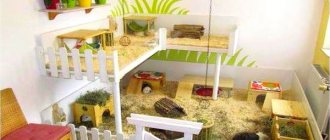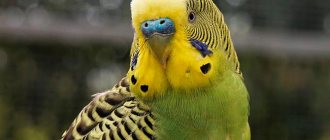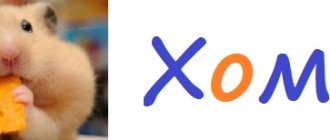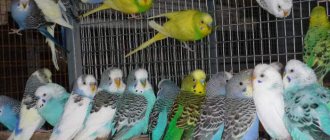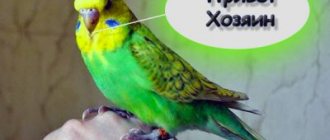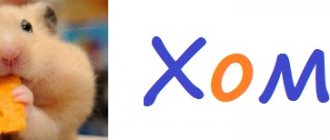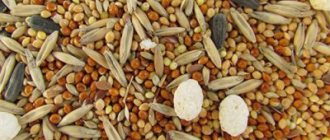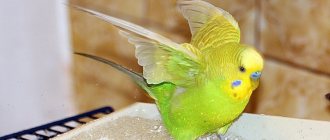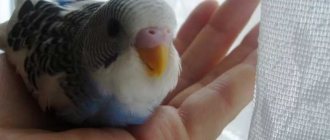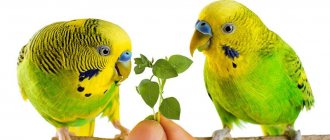Budgerigars are successfully kept at home - beautiful birds with a peaceful and curious character. They get along well with people and do not feel much discomfort in captivity, but for this it is necessary to create appropriate conditions for their life.
When purchasing a parrot for your home, you should immediately buy a cage for it, where it will spend a significant part of its time. The choice of this accessory should be taken with full responsibility, since the health and lifespan of your feathered friend depend on the conditions of detention.
In the article we will tell you what a cage for a budgie should be like, the optimal design, dimensions, material, what a budgie needs in a cage, mandatory items and additional accessories for organizing the space, where it is best to place the cage with a parrot, whether it needs to be covered with a cloth at night .
The right cage for a budgie - what to look for
- Size. Depends on how much time the pet will spend locked up. Sleep, food or most of the day? The more time he is locked up, the larger the size of housing he needs.
- Minimum. The minimum size of a cage for a budgie is: length not less than 40 cm, width not less than 25 cm, and height more than 45 cm. Remember that this is only a minimum, similar to the sanitary norm of 6 meters of living space per person. If possible, try to choose more spacious accommodation.
- Form. Choose models of a simple rectangular shape with a flat or semicircular roof; they are comfortable for the bird and easy for the owner to clean.
- Distance between rods. The optimal value is 1-1.5 cm.
- Arrangement of rods. Horizontal rods are more comfortable for the parrot.
- Access to feeders. It is better if there is external access, then you will not disturb the bird when changing food.
With toys
Petmax Bianca
For those who want to purchase an economical option with toys without harming their pet, this product will be the best choice. The manufacturing material does not contain toxic substances, the bright color of the product will also delight small birds.
The cage contains a swing and several perches that add variety to the parrot's life. The dimensions of the home are not intended for several birds to live in, so toys will be required. Design features will make cleaning easier, preventing debris from spilling out of the cage; the plastic tray is easy to wash.
Petmax Bianca cage
Advantages:
- low price;
- comfortable shape;
- easy to clean;
- safety;
- The high side will prevent debris from spilling out.
Flaws:
- small dimensions;
- there is no feeder.
The average cost is 800 Russian rubles.
Ferplast Bali
This product is somewhat more expensive than the analogues described above, but its quality fully corresponds to the price. The above brand is very popular among professionals and amateurs; many positive reviews also add advantages to the product.
As for toys, they are presented in large quantities: mirror, bells, swings, perches. There is also a drinking bowl, feeder and clothespin for goodies. The cage is quite spacious, but it is intended to contain one or two small birds. You can install the home on a hard horizontal surface, or you can hang it by a ring. The product is available in two colors: white and gold.
cage Ferplast Bali
Advantages:
- wide range of colors;
- lots of toys;
- large dimensions;
- easy to clean.
Flaws:
- high price.
The average cost is 5,000 Russian rubles.
How to set up a cage for a budgie
Perches
At least 2-3 pieces. The main ones are wooden with bark, the additional ones are mineral and rope.
Drinking bowl and feeders
There should be several feeders, at least 2 pieces: for dry grain food and for wet food, for example, porridge, sprouts or vegetables.
Toys
A must-have element so that your feathered pet doesn’t get bored. 3-4 toys are enough if you replace them periodically. One of the fun items should be a forage toy that stimulates food search and mental activity.
Bathing suit
It is placed in the enclosure only for bathing time, and is removed at other times. The bird should not be left alone unattended during water procedures.
Fruit holders
An accessory that can attract a parrot to healthy foods. A playful presentation will help the bird take a different look at its unloved vegetable.
Sepia, mineral stones
A source of calcium, an essential attribute in the lattice apartment.
Lighting
If the bird receives little sunbathing in the summer, then place a special ultraviolet lamp above the cage. There are 2 brands in Russia that produce lamps directly for birds: Arcadia and Bird Systems.
Cape
Allows you to regulate the bird's daily routine. The bird's daylight hours should be 10-14 hours, depending on the time of year; the rest of the time the feathered pet should sleep. If this cycle is disrupted, behavioral and health problems may arise.
Is it possible to make a house with your own hands?
Making a cage yourself is a labor-intensive task that requires carpentry skills. Designs of this type are not suitable for beginners as a test of the pen. In this case, it is much more practical to look at some budget solution and modify it at your own discretion.
The simplest homemade option is a combined design: wooden frame and metal mesh . The drawing can be copied from factory solutions, which can be studied either in the nearest pet store or in an online store. The main thing is that after assembly there are no sharp or protruding elements left (screws, rods, etc.).
It is also useful to read: Diet of a budgerigar
Rules for safe cage location
- Keep in mind that the parrot is comfortable being at eye level with the owner. Therefore, decide in advance where the lattice apartment will be placed: on a cabinet/table or on the included stand on wheels.
- The best place for the cage is in the room where the owner spends most of his time.
- You should not place the cage next to electrical appliances, in a draft or direct sun, from which the parrot will not be able to go into the shade.
- Remember that the kitchen is a high-risk place. Boiling water, open fire, or simply hot objects make it unreasonably dangerous for a parrot to be in the kitchen.
What should the poles be like?
When you purchase a cage, it already comes with perches.
They are made of plastic, thin and hollow inside. As a result, such crossbars become a convenient breeding ground for bedbugs and microbes. When a parrot chews on them, plastic gets into its stomach, which can kill it. Thin crossbars cause calluses on the paws. You can replace them with ready-made ones. You should choose rubber, flexible ones. The material must be free of dyes and suitable for the diameter of the bird. In addition to them, it is necessary to periodically install crossbars made of pumice - to grind off the claws. You can just buy rope ones with wire inside. In any case, you will have to trim the bird's claws. The wavy can become entangled in the threads of a chewed rope.
Perches for budgies should be:
- made from natural material;
- hard enough to drive claws in;
- diameter 12 – 18mm.
Perches must be made of natural wood
The bird's leg is designed in such a way that when it grasps a branch, the tendons are stretched, the claws dig into the surface and the parrot, without straining, can spend several hours sleeping, pecking at fruits and resting in the shade of the leaves. He makes efforts by leaving the crossbar and tearing his paws off it.
The best option to create comfort for your pet is to make perches for parrots with your own hands. To do this, you need to take straight branches from trees that are useful for birds.
- Trim branches 8–10mm longer than the width of the cage.
- Place them in a saucepan and load them so that they do not float. Boil for 20 minutes.
- Remove bark. Polish with sandpaper. The cross-section may have differences, but the diameter should be 15 - 18 mm (1.5 - 1.8 cm) for an adult budgerigar.
- Make grooves at the ends - cut with a knife to a depth of 5 - 6mm. The bars of the cage are wound into them.
There should be 2 crossbars in a cage for one parrot. One is located near the feeder. The bird will eat from it. The second one is diagonally at the top. Parrots love to climb higher. In an aviary with several birds, how many perches are installed. The rule is simple.
- The parrot should be able to freely flutter from one to another.
- There is no need to place anything like swings, bridges or other crossbars under the crossbars. It will be stained with bird feces. Birds cannot control this process.
- The perches should not confine the birds, prevent them from spreading their wings, or touching their tails.
Perches should not interfere with pets
For a young parrot, the best perches are conical ones from 8mm to 15mm. He will choose where it is more convenient for him to sit. By replacing them with new perches, you can make them even, adjusting them to the size chosen by the wavy. If the bark on the branch is smooth and clean, you don’t have to remove it, just treat it with boiling water or in the oven.
You can attach a short perch to one wall in different ways.
- At the end, mark the center for the self-tapping screw.
- Place 2 washers and partially tighten the screw.
- Insert the crossbar into the cage so that the rods are between the two washers. Tighten the screws, squeezing them and fixing the crossbar to the cage wall.
By analogy, a more durable fastening is made. Drill a hole, insert a pin with washers and tighten it with a nut.
You can make perches for parrots yourself
Recommended Models
Our online pet store offers the largest range of cages for parrots with delivery throughout Russia. Below is a list of popular apartments.
Close
Ferplast Piano 4
Rating
4.9 out of 5 RUB 6,991.00
Dimensions: 59x33x55 cm
Add to My Wishlist
Add to cart
Quick view
Close
Savic Primo 50
Rating
4.5 out of 5 RUB 5,981.00
Dimensions: 65x38x56.5cm
Add to My Wishlist
Add to cart
Quick view
Close
Ferplast Piano 3
Rating
4.78 out of 5 RUB 5,904.00
Dimensions: 50x30x52.5 cm
Add to My Wishlist
Add to cart
Quick view
Close
Savic Primo 60 Open Empire
Rating
5 out of 5 RUB 12,239.00
Dimensions: 80x50x95cm
Add to My Wishlist
Add to cart
Quick view
Close
Inter-Zoo Nina
Rating
4.6 out of 5 RUB 6,313.00 – RUB 6,484.00
Dimensions: 54x34x74 cm
Add to My Wishlist
Choose …
Quick view
Close
Ferplast Palladio 4
Rating
4.84 out of 5 RUB 7,558.00
Dimensions: 59x33x69 cm
Add to My Wishlist
Add to cart
Quick view
Not available
Close
Triol 7005
Rating
4 out of 5 RUB 2,722.00
Dimensions: 43×30.5×58 cm
Add to My Wishlist
More details
Quick view
Close
Inter-Zoo Eliza
Rating
4.22 out of 5 RUB 6,653.00 – RUB 6,828.00
Dimensions: 54x34x75 cm
Add to My Wishlist
Choose …
Quick view
Close
IMAC Tasha with partition
Rating
4.5 out of 5 RUB 10,681.00
Cage dimensions: 80.5x49x65 cm
Add to My Wishlist
Add to cart
Quick view
Close
IMAC Irene 4
Rating
4.31 out of 5 RUB 7,099.00
Dimensions: 59x38x56 cm
Add to My Wishlist
Add to cart
Quick view
Close
IMAC Camilla
Rating
5 out of 5 RUB 6,887.00 – RUB 7,753.00
Dimensions: 50x30x57/129 cm
Add to My Wishlist
Choose …
Quick view
Close
Inter-Zoo Elena
7 615,00₽
Dimensions: 54x39x71 cm
Add to My Wishlist
Add to cart
Quick view
Varieties
Pet stores offer a huge number of toys made from various materials and designed for wavy animals. They can be used inside or outside the cage and have different functions.
Some things are needed to sharpen the beak and nails, while others develop intelligence. There must be toys designed for the full physical development of the pet.
Before purchasing a finished product, it is important to make sure that there are no glue residues or small objects on the surfaces that the parrot could tear off and swallow.
For sharpening the beak
The beak of the wavy is covered on top with a horny layer, which is easily ground off.
To do this, the parrot must have constant access to special objects that are used to sharpen its beak. You can use special toys made of wood or plastic.
The basic rule to follow is the safety of the material used. Typically, such toys are represented by a dummy bird, wooden sticks attached to the wall of the cage, as well as perches with unusual protrusions.
Intelligent
Their purpose is to develop the mental abilities of the bird. They are represented by special educational puzzles, upon solving which the bird gains access to some kind of delicacy.
Usually labyrinths or special balls are used for these purposes, which are closed on several sides, but have recesses into which the wavy can insert its beak. With regular use of such toys, the pet becomes more intelligent, and this often has a positive effect on the speed of speech learning.
Do you buy toys for your parrot?
Not really
For physical development
Since pet parrots don't move much, they require special items to help them maintain optimal physical condition. For this purpose, special rings, perches, bungees and ladders are used.
But it is not recommended to overdo it with these elements, since otherwise the parrot simply will not have room for quiet rest and relaxation. You need to place purchased or made elements at different heights.
Interactive
They consist in the fact that the bird must perform certain actions in order to receive a certain delicacy. Sometimes such toys produce sounds when pressed, which arouses the parrot's interest.
Some birds do not understand what needs to be done with an interactive toy, so the human task is to show the principle of operation of the item.
Popular questions and answers to them
- Cage for two budgies - what size? Minimum dimensions: 60 cm in height, from 60 cm in length and at least 35 cm in width.
- What to put in the bottom of a budgie's cage? You can use: sea sand fillers, wood or corn pellets, white paper. Not allowed: newspapers, magazines, silica gel cat litters.
- Is it worth hanging up a nesting house? No, it's not worth it if you don't intend to breed.
- When can a budgie be released from its cage? If the bird was purchased at a regular pet store, then you need to give it a month to get used to it; if the feathered pet was purchased from a breeder, he is a fosterling, and is not afraid of hands, then you can release him almost immediately.
- When should you start teaching conversation? Better from the first days of arrival in the house. Remember that classes should have an exclusively positive attitude. You cannot exercise in a bad mood or scold the bird.
- Is it possible to have a mirror in a budgie's cage? It is possible if, in addition to the mirror, the bird has many other toys and accessories, and the owner himself engages in playing with the pet. If the bird has only one mirror, then naturally this will lead to a problem - the bird, out of boredom, will begin to communicate with its reflection, perceiving it as a partner.
- Is it possible to allow flights around the apartment? Yes, flying is vital for your health. However, they must be controlled, i.e. the owner must make sure that there are no dangers in the form of an open window or a randomly slamming door.
- Is it acceptable to keep with other animals? No, you cannot leave your winged friend with another pet unattended, even if they get along well with each other, there is always a tragic accident.
- Is it possible to keep a cockatiel and a wavy in the same cage? No you can not. Despite the fact that they are both peace-loving creatures, quarrels can still arise, which means injuries. It is impossible to choose one optimal diet for different types of birds, and feeders are common.
Acceptable Materials
Birds love to chew on perches, toys and twigs. To prevent toxic substances from entering the body, the parrot's cage must be made of safe materials.
Important: High quality stainless steel is considered the best material. It is not subject to oxidation and does not rust.
Cheap house models made from materials of dubious quality threaten the health of pets. Galvanized rods can cause poisoning to a parrot. No less dangerous is copper, which quickly oxidizes. Its oxides act as a strong poison on birds.
Wooden parrot cages are only suitable for temporary housing. Budgerigars gnaw through them with ease. Wood absorbs moisture, becoming a favorable environment for the growth of bacteria.
A good option is a plastic structure. This material is non-toxic, but is susceptible to high temperatures. Therefore, houses made from it cannot be washed with hot water.
Feeder
Experienced owners advise purchasing several feeders at once, each of which will be used for a separate type of feed. Grains or dry food are usually poured into one, and mineral supplements into the other. You can separately purchase a feeder for a variety of treats.
Usually, feeders are purchased that are suspended at a height from rods. The food is poured in from the outside, allowing you to simplify the feeding procedure - the bowl does not need to be constantly taken out and then returned. It is recommended to opt for a large feeder, then the wavy will be able to independently choose the most suitable pieces.
The most suitable material of manufacture is ceramics, but you can opt for plastic.
Drinking bowl
It is also better to purchase a drinking bowl so that it can be hung on rods. This makes it easier to change the fluid and also avoid the appearance of dampness inside. A closed drinking bowl has its advantage - the water stays fresh longer. If you have the finances, you can spend money on buying an automatic drinker. Its advantage is its autonomy, but its main disadvantage is not the longest service life. For this reason, such a purchase should only be purchased if the owner leaves home for a long time, leaving the pet alone.
Automatic drinker.
Closed drinking bowl.
